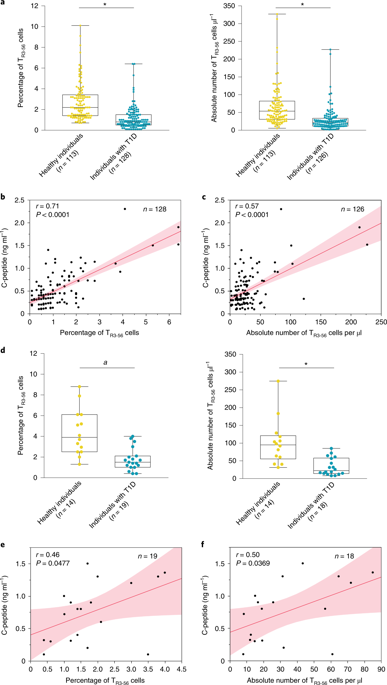Nature Metabolism ( IF 18.9 ) Pub Date : 2020-02-17 , DOI: 10.1038/s42255-020-0173-1 Giuseppe Terrazzano 1, 2 , Sara Bruzzaniti 3, 4 , Valentina Rubino 1, 2 , Marianna Santopaolo 3 , Anna Teresa Palatucci 1 , Angela Giovazzino 2 , Claudia La Rocca 3 , Paola de Candia 5 , Annibale Puca 5 , Francesco Perna 6 , Claudio Procaccini 3, 7 , Veronica De Rosa 3, 7 , Chiara Porcellini 2 , Salvatore De Simone 3 , Valentina Fattorusso 2 , Antonio Porcellini 4 , Enza Mozzillo 2 , Riccardo Troncone 2, 8 , Adriana Franzese 2 , Johnny Ludvigsson 9 , Giuseppe Matarese 3, 10 , Giuseppina Ruggiero 2 , Mario Galgani 3, 10

|
An unresolved issue in autoimmunity is the lack of surrogate biomarkers of immunological self-tolerance for disease monitoring. Here, we show that peripheral frequency of a regulatory T cell population, characterized by the coexpression of CD3 and CD56 molecules (TR3-56), is reduced in individuals with new-onset type 1 diabetes (T1D). In three independent T1D cohorts, we find that low frequency of circulating TR3-56 cells is associated with reduced beta-cell function and with the presence of diabetic ketoacidosis. Since autoreactive CD8+ T cells mediate disruption of insulin-producing beta cells1,2,3, we demonstrate that TR3-56 cells can suppress CD8+ T cell functions in vitro by reducing the levels of intracellular reactive oxygen species. The suppressive function, phenotype and transcriptional signature of TR3-56 cells are also altered in children with T1D. Together, our findings indicate that TR3-56 cells constitute a regulatory cell population that controls CD8+ effector functions, whose peripheral frequency may represent a traceable biomarker for monitoring immunological self-tolerance in T1D.
中文翻译:

T1D 进展与控制 CD8+ T 细胞效应功能的 CD3+CD56+ 调节性 T 细胞的丧失有关。
自身免疫中一个未解决的问题是缺乏用于疾病监测的免疫自我耐受性的替代生物标志物。在这里,我们展示了以 CD3 和 CD56 分子 (T R3-56 ) 共表达为特征的调节性 T 细胞群的外周频率在新发 1 型糖尿病 (T1D) 个体中降低。在三个独立的 T1D 队列中,我们发现循环 T R3-56细胞的低频率与降低的 β 细胞功能和糖尿病酮症酸中毒的存在有关。由于自身反应性 CD8 + T 细胞介导产生胰岛素的 β 细胞1,2,3的破坏,我们证明 T R3-56细胞可以抑制 CD8 +T 细胞通过降低细胞内活性氧的水平在体外发挥作用。T1D 儿童的 T R3-56细胞的抑制功能、表型和转录特征也发生了改变。总之,我们的研究结果表明,T R3-56细胞构成了控制 CD8 +效应器功能的调节细胞群,其外周频率可能代表用于监测 T1D 免疫自我耐受性的可追踪生物标志物。











































 京公网安备 11010802027423号
京公网安备 11010802027423号